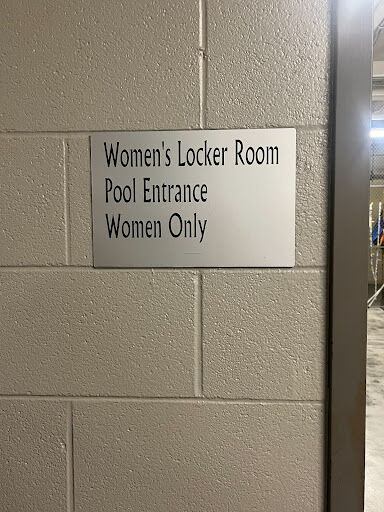
The women's entrance to the pool via locker room sits in the basement of the HPER building. The olympic-sized swimming pool has been closed to the public for three years.
When asked his feelings about the extended closure of Emporia State’s campus swimming pool, sophomore Jacob Waugh responded, “there’s a pool?”
The half-century old swimming pool located in the HPER building has been unavailable to the public since the COVID-19 emergency declaration of 2020, before many current students began attending ESU. Despite its co-occurrence, the pool was not closed due to the pandemic.
According to Mike Wise, director of Recreation Services, the pool had to close due to the cost of operation, the cost of upgrading its features to meet federal regulations, and the challenge of finding lifeguards.
Before the pandemic, the pool’s use was divided by an agreement between academics, athletics, and recreation services, granting each department priority to use the pool at different times in the day. From 6:00 p.m. to close, the pool belonged to Recreation Services, and anyone was allowed to swim.
Most of the time only a small population of people used the swimming pool recreationally, and during some hours nobody swam at all.
Regardless, there had to be two lifeguards on duty at all times. Paying them, in addition to maintaining the old pool, cost Recreation Services forty dollars per hour for operation. Finally, in order to change the drainage system and fix other age-related issues with the pool to meet federal regulations, the department would have to pay close to a million dollars. Due to these challenges and insufficient funding, Recreation Services backed out of their share of the pool, and that change happened to take effect as the pandemic took off.
Amidst talk of converting the pool area into something else, the future of the olympic-sized swimming pool and its space remain uncertain.
“When I last heard, they were talking about either converting it into an athletic fieldhouse type thing or making another level and adding offices up above and you know, workout areas below,” Wise said. “But you know, those were just wish lists. I don’t think that there’s really been any conversation as far as what the future of the pool looks like moving forward… I think that academic programming is [the university’s] focus at this point.”
While the pool has remained closed to the public for three years, it has continued to be used by academics and athletics for classes and physical therapy.